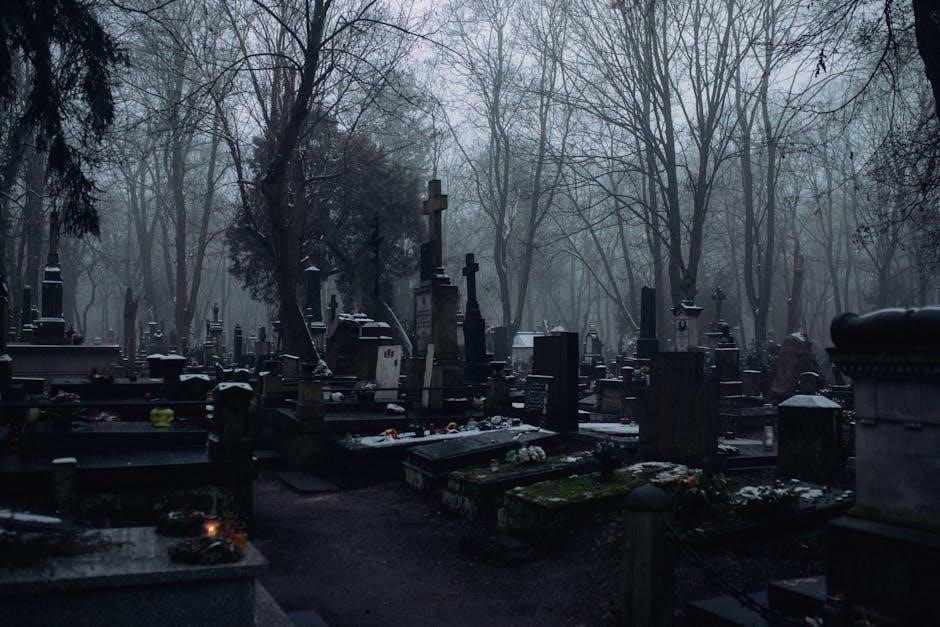Emily Dickinson’s “Because I Could Not Stop for Death” is a profound exploration of mortality, personifying Death as a courteous suitor and Immortality as a silent companion, reflecting Dickinson’s contemplative tone and unique stylistic approach.
1.1. Brief Overview of the Poem
“Because I Could Not Stop for Death” by Emily Dickinson is a profound exploration of mortality, eternity, and the afterlife. The poem personifies Death as a courteous suitor who escorts the speaker on a journey through eternity, accompanied by Immortality. Dickinson’s unique style, rich imagery, and contemplative tone create a reflective and calm atmosphere, inviting readers to ponder life’s transient nature and the inevitability of death.
1.2. Emily Dickinson’s Background and Style
Emily Dickinson, a reclusive 19th-century poet, crafted unique verse marked by unconventional structure, dashes, and capitalization. Her style reflects introspection and depth, often exploring themes of death, nature, and spirituality. Dickinson’s isolation likely shaped her distinctive voice, blending simplicity with profound complexity, creating a timeless literary legacy that continues to captivate readers with its originality and emotional resonance.

Historical Context and Publication
“Because I Could Not Stop for Death” was written in the mid-1800s by Emily Dickinson, a reclusive poet whose work was largely unpublished during her lifetime. The poem was first published posthumously in 1890, gaining recognition for its unique exploration of mortality and eternity, resonating deeply with its audience.
2.1. The Era in Which the Poem Was Written
Emily Dickinson wrote “Because I Could Not Stop for Death” in the mid-1800s, a time marked by Civil War, societal change, and intellectual exploration. The era’s cultural and philosophical shifts influenced her themes of mortality, eternity, and individual contemplation. Dickinson’s reclusive lifestyle and unique poetic style further set her work apart during this transformative period in American history and literature.
2.2. The Poem’s Publication History
Emily Dickinson’s poem was first published posthumously in 1890, edited by Mabel Loomis Todd and Thomas Wentworth Higginson. It appeared in the first collection of her poems, Poems, which introduced her unique style to the world. The poem gained recognition for its profound exploration of mortality and eternity.
Over time, it became one of Dickinson’s most celebrated works, included in numerous anthologies and studies. The 1955 publication of her complete poems by Thomas H. Johnson further cemented its place in literary history, showcasing Dickinson’s genius to a broader audience.
Themes and Symbolism
The poem explores themes of Death, Immortality, and the Afterlife, using symbolism to convey the speaker’s journey and introspection about eternity.
3.1. Death as a Central Theme
Death is portrayed as a courteous suitor, personified as a gentleman caller who accompanies the speaker on a timeless journey. The poem presents death not as an end but as a transition, blending calmness with profound introspection. Dickinson’s unique perspective transforms death into a natural, even welcoming, event, rather than a feared occurrence, emphasizing its inevitability and the eternity that follows.
3.2. Immortality and Its Significance
Immortality emerges as a comforting concept, suggesting life extends beyond earthly bounds. The poem conveys that death is not an end but a transition to eternity, where time loses meaning. Dickinson portrays immortality as a natural state, offering solace and continuity, emphasizing that the soul’s journey persists, free from mortal constraints and earthly worries, into an eternal realm of peace and timeless existence.
3.3. Symbolism in the Carriage Ride
The carriage ride symbolizes the journey of life toward eternity. It represents a smooth transition from mortality to immortality, guided by Death. The carriage, a common mode of transport, becomes a metaphor for the soul’s passage, emphasizing the inevitability and acceptance of death. This imagery reinforces the poem’s calm tone, suggesting death is a natural, uninterrupted journey rather than an abrupt end.

Poetic Structure and Style
Dickinson’s unconventional style features irregular meter and slant rhyme, creating a unique rhythm. Her use of dashes and capitalization emphasizes themes and emotions, reflecting her innovative poetic voice.
4.1. Dickinson’s Unique Meter and Rhyme
Emily Dickinson’s poetry, including “Because I Could Not Stop for Death,” features a distinctive meter and rhyme scheme. She often employs a ballad-like structure with a common meter, though her use of dashes and irregular stresses creates a unique rhythm. Her slant rhyme adds a subtle musicality, enhancing the poem’s contemplative tone. This unconventional approach reflects her innovative style, blending traditional forms with personal expression.
4.2. The Use of Dash and Capitalization
Emily Dickinson’s unique style in “Because I Could Not Stop for Death” includes frequent use of dashes and unconventional capitalization. The dashes create pauses, adding a contemplative rhythm, while capitalizing nouns like “Death” and “Eternity” emphasizes their significance. This stylistic choice reflects her individualistic approach, enhancing the poem’s introspective and philosophical tone. Her innovative use of punctuation and capitalization remains a hallmark of her poetry.

Personification in the Poem
Dickinson personifies Death as a courteous suitor and Immortality as a companion, transforming abstract concepts into relatable characters, which adds depth to the poem’s exploration of mortality and eternity.
5.1. Death Personified as a Gentleman
Death is personified as a courteous gentleman who stops for the speaker, embodying a paradox of kindness and inevitability. This portrayal softens death’s fearsome image, presenting it as a polite suitor rather than a grim figure. The gentle mannerisms, like stopping and waiting, humanize death, making it appear approachable and even welcoming, which contrasts with its inherent finality and mystery.
5.2. Immortality as a Companion
Immortality is depicted as a silent, eternal companion in the carriage, emphasizing the journey’s infinite nature. Dickinson’s portrayal of immortality as a quiet, unobtrusive presence underscores the speaker’s acceptance of death and the afterlife. This duality of death and immortality highlights the inevitability of eternity, blending the finite with the infinite in a serene, contemplative manner.
Mood and Tone
The mood is calm and reflective, featuring a serene acceptance of death. The tone shifts from detachment to a peaceful, almost welcoming contemplation of eternity.
6.1. The Calm and Reflective Tone
The poem maintains a calm and reflective tone, with the speaker addressing death in a serene manner. Dickinson’s gentle imagery, such as the carriage ride, evokes a meditative mood. The speaker’s peaceful demeanor contrasts sharply with the fear typically associated with death, creating a sense of acceptance and tranquility. The tone is steady and deliberate, mirroring the slow, inevitable journey toward eternity.
6.2. The Transition from Life to Death
The poem masterfully depicts the transition from life to death as a gradual, peaceful process. The speaker’s journey with Death, personified as a courteous suitor, symbolizes the inevitable shift from mortality to eternity. The carriage ride represents the passage, with the speaker leaving earthly concerns behind. Dickinson’s imagery of dew and evening sun emphasizes the quiet, natural progression into the unknown, reflecting the speaker’s acceptance of this universal transition.

The Journey Motif
The poem’s central motif of a carriage ride symbolizes the journey of life, guiding the speaker through time and eternity with Death as a polite suitor.
7.1. The Carriage Ride as a Symbol of Life’s Journey
The carriage ride in the poem symbolizes the speaker’s life journey, progressing from childhood to death. The slow, deliberate pace mirrors life’s passage, with Death as the courteous guide. The ride passes by schools, fields, and houses, representing life’s stages, ultimately leading to eternity, where time loses meaning, and the speaker’s mortal journey concludes in an endless vastness.
7.2. The Stops Along the Way
The carriage pauses at significant life milestones: a school, fields of grain, and a setting sun. These stops symbolize childhood, productivity, and life’s decline. Each pause reflects the speaker’s detachment from earthly concerns, emphasizing the inevitability of death. The journey’s progression underscores the natural transition from life to eternity, highlighting the speaker’s acceptance of mortality’s relentless pace.

The Significance of “Eternity”
Eternity symbolizes the infinite and unchanging nature of death and the afterlife, contrasting with life’s fleeting moments. It underscores the poem’s exploration of mortality and timeless existence.
8.1. Eternity as a Concept in the Poem
Eternity is portrayed as an endless, timeless state, contrasting with the finite nature of human life. The poem explores it through Death’s courteous guidance, symbolizing inevitability and the afterlife’s mystery. The carriage ride embodies a journey into eternity, where earthly concerns like labor and leisure lose meaning. Dickinson’s imagery underscores the transition from mortal time to eternal stillness, highlighting the soul’s immortal essence and the infinite beyond life’s bounds.
The poem’s focus on eternity emphasizes the timeless and unchanging nature of death, while the speaker’s calm acceptance reflects a surrender to the eternal unknown. This concept centralizes the poem’s exploration of mortality, immortality, and the soul’s enduring journey, leaving readers with a profound meditation on life’s transient nature and eternity’s vast, unknowable expanse.
8.2. The Speaker’s Perception of Time
The speaker views time with detachment, as if it has lost relevance. The poem’s progression from day to eternity illustrates a shift from mortal time to timeless consciousness. Dickinson uses the carriage ride to symbolize life’s journey, where earthly measurements of time fade. The speaker’s calm tone reflects acceptance of time’s passage, emphasizing the infinite over the finite.
The Role of Nature in the Poem
Nature serves as a serene backdrop, with imagery like sunset and dew symbolizing life’s transient journey and the eternal transition to death.
9.1. The Setting of the Poem
The poem unfolds in a serene, countryside setting, evoking a sense of calm and tranquility. The speaker describes a carriage ride through fields and past grain, symbolizing life’s journey. The natural imagery, such as the setting sun and dew, creates a peaceful backdrop, contrasting with the solemn theme of death. Dickinson’s use of nature emphasizes the timeless and universal quality of the poem’s meditation on mortality.
9.2; The Imagery of Sunset and Dews
The imagery of sunset and dews in the poem symbolizes the transition from life to death. The setting sun represents the end of earthly time, while the dews evoke a sense of coolness and finality. These natural elements create a serene yet somber atmosphere, underscoring the speaker’s calm acceptance of mortality. Dickinson’s use of these images reinforces the poem’s themes of eternity and the passage of time.
The Speaker’s Attitude Toward Death
The speaker accepts death with calmness and curiosity, showing no fear. Death is portrayed as a courteous suitor, guiding her gently toward eternity, reflecting her serene resignation.
10.1. Acceptance and Surrender
The speaker exhibits a calm acceptance of death, viewing it as an inevitable journey rather than a fearful event. Death is portrayed as a gentle suitor, guiding her with courtesy. This resignation is evident in her willingness to pause her life and embrace eternity, reflecting a peaceful surrender to the unknown, free from resistance or despair.
10.2. The Speaker’s Detachment from Earthly Life
The speaker gradually distances herself from earthly concerns, exemplified by her transcendence of worldly matters. The carriage ride symbolizes her departure from life, leaving behind the sun, dews, and mortal routines. Her calm demeanor reflects a quiet release from earthly ties, emphasizing her readiness to embrace eternity without clinging to temporal existence or expressing regret.
Critical Analysis and Interpretations
Scholars view the poem as a profound meditation on mortality, with Dickinson’s unique style capturing the complexities of death and eternity through subtle imagery and symbolism.
11.1. Scholarly Views on the Poem
Scholars interpret the poem as a contemplation of mortality, where Death is personified as a courteous suitor. The carriage ride symbolizes life’s journey, with stops representing life’s stages. Dickinson’s calm tone contrasts with the gravity of death, offering a unique perspective on eternity. Critics praise her ability to blend profound themes with subtle imagery, challenging traditional views of death and immortality through her distinctive style and introspection, making it a cornerstone of American literature.
11.2. Modern Interpretations and Relevance
Modern readers draw parallels between Dickinson’s exploration of mortality and contemporary existential questions. The poem’s universal themes of life, death, and eternity resonate deeply, making it timeless. Its unique style and profound introspection continue to inspire literary discussions, while its accessibility fosters connection with diverse audiences, ensuring its relevance in today’s cultural and academic landscapes.

The Poem’s Popularity and Impact
The poem’s profound exploration of mortality and eternity resonates universally, making it a timeless classic. Its unique style and depth have cemented its place in literature.
Widely studied and shared, it continues to inspire reflections on life and death, ensuring its enduring popularity and cultural significance across generations and academic circles.
12.1. Why the Poem Resonates with Readers
Readers connect deeply with the poem’s exploration of universal themes like mortality, eternity, and the afterlife, presented with Dickinson’s unique blend of simplicity and profound depth. Its gentle yet haunting portrayal of death as a courteous suitor, coupled with the speaker’s calm acceptance, evokes introspection and emotional resonance, making it relatable across generations and cultural boundaries.
12.2. Its Place in Dickinson’s Oeuvre
This poem stands as one of Dickinson’s most celebrated works, exemplifying her unique style and profound exploration of mortality. Its innovative structure, dashes, and capitalization reflect her unconventional approach to poetry. The poem’s themes of death and eternity resonate deeply within her oeuvre, showcasing her mastery of introspective and philosophical verse, solidifying its status as a cornerstone of her literary legacy.

Availability in PDF Format
The poem is widely available in PDF format on academic databases, educational websites, and literary archives, often accompanied by study guides and annotations for deeper analysis.
13.1. Sources for the PDF Version
The PDF version of “Because I Could Not Stop for Death” can be found on academic platforms like JSTOR, Google Scholar, and educational websites such as Scribd or Academia.edu. These sources often provide the poem alongside study guides and annotations for better understanding. Additionally, official Emily Dickinson archives and literary websites offer reliable PDF downloads for scholarly purposes.
13.2. Study Guides and Annotations
Study guides and annotations for the PDF version of “Because I Could Not Stop for Death” are widely available on educational platforms like SparkNotes, LitCharts, and eNotes. These resources provide in-depth analyses of themes, symbols, and poetic devices. They also offer historical context and insights into Dickinson’s unique style, aiding readers in understanding the poem’s complexity and significance. Many guides include discussion questions and essay prompts for further exploration.

Educational Resources and Study Materials
14.1. Class 12 Alternative English Curriculum
The poem is included in Class 12 Alternative English curriculum, with study materials available on CBSE and educational platforms, offering analyses and activities for deeper understanding.
The poem is part of the Class 12 Alternative English curriculum, with PDF resources available on educational websites like CBSE and Scribd. These resources include detailed study guides, teacher notes, and student activities. They provide in-depth analyses of themes, poetic devices, and historical context, aiding students in understanding Dickinson’s unique style and preparing for exams. Online platforms like Khan Academy and SparkNotes also offer interactive analyses.
14.2. Online Platforms for Analysis
Online platforms like SparkNotes, LitCharts, and Khan Academy provide detailed analyses of the poem. These websites offer study guides, interactive elements, and expert insights, making them invaluable for students and readers seeking a deeper understanding of Dickinson’s work. They also include discussions on themes, symbolism, and poetic structure, enhancing the learning experience for those exploring “Because I Could Not Stop for Death.”

Frequently Asked Questions
- What is the poem about?
- What themes does it explore?
- Where can I find the PDF version?
- Why is it significant in literature?
15.1. Common Questions About the Poem
Readers often inquire about the poem’s themes, such as death and immortality. Questions include: “What does the carriage ride symbolize?” “How does Dickinson portray death?” “Where can I find a reliable PDF version?” “What literary devices does she use?” and “Why is this poem considered a masterpiece of American literature?” These questions reflect its enduring relevance and depth.
15.2. Answers from Literary Experts
Literary experts highlight Dickinson’s exploration of mortality, immortality, and the afterlife. They note her unique style, blending simplicity with profound depth. The poem’s themes of death as a courteous suitor and the speaker’s calm acceptance are often praised. Experts also emphasize the universality of its themes, making it a timeless masterpiece. PDF versions with annotations provide deeper insights into her poetic genius and cultural impact.
Dickinson’s timeless poem continues to captivate with its profound exploration of mortality, eternity, and existence. Its unique style and universal themes ensure its enduring relevance and appeal.
16.1. The Timeless Appeal of the Poem
The poem’s timeless appeal lies in its universal themes of mortality, eternity, and life’s journey. Dickinson’s unique style, blending profound introspection with nature’s imagery, creates a hauntingly beautiful reflection on existence. Its exploration of death as a gentle companion, rather than a feared entity, resonates deeply, offering solace and perspective to readers across generations.
16.2. Encouragement for Further Exploration
Exploring “Because I Could Not Stop for Death” offers profound insights into Dickinson’s philosophy on life, death, and immortality. Readers are encouraged to delve deeper into her unique style and symbolism, as well as seek out study guides and PDF versions of the poem for enhanced analysis. This masterpiece invites continuous reflection and appreciation of its timeless themes.
